Effects Of Force On An Object
A push or a pull acting on an object is called force. The SI unit of force is newton (N). We use force to perform various activities. In common usage, the idea of a force is a push or a pull.
 Figure shows a teenage boy applying a force to push a ball and a young boy applying a force to pull a kite.
Figure shows a teenage boy applying a force to push a ball and a young boy applying a force to pull a kite.
The action of a force can cause
(a) a stationary object to move,
(b) a moving object to change its speed,
(c) a moving object to change its direction of motion,
(d) an object to change in size and shape.
Force has the following effects on objects
Force can make a stationary object move or make a moving object move faster
A toy car can be made to move by giving it a little push. Similarly, a stationary football can be made to move by giving it a small push (i.e., by kicking it). If we have an already moving toy car or ball, we can make it move faster by giving it a push in the direction in which it is moving. Thus, a force can make a stationary object move, and it can also make an already moving object move faster.
Force can slow down or completely stop a moving object
A moving toy car can be made to stop by applying a force. A bicycle can be stopped or slowed down by applying the brakes. In football, the force applied by the goalkeeper stops the ball hit towards the goal. In order to stop or slow down a moving body, we need to apply a force in a direction opposite to the direction of motion of the moving body.
Force can change the direction of a moving object
In cricket, when a batsman hits the ball that is bowled at him, the direction in which the ball is moving changes. In football, the players can change the direction of the moving ball by kicking it in a different direction. In these examples, force changes the direction of a moving object.
Force can change the shape or size of an object
While making chapattis, we change the shape of the dough by applying force with our hands. The shape of a rubber band changes when it is pulled. You can also break things by applying a force. Materials that break easily when we apply a force are termed brittle. For example, objects made of glass and clay break easily when we apply force on them.
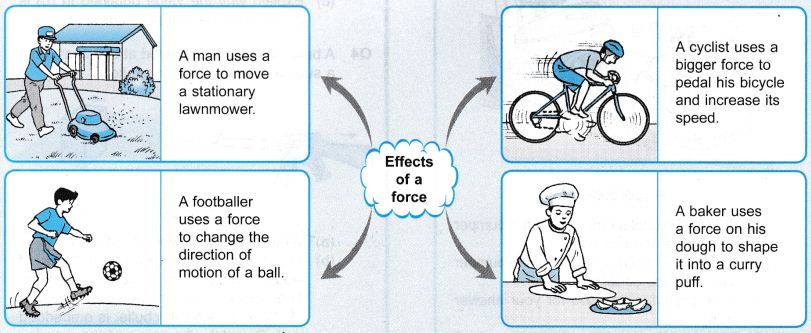
Activity 1
Aim: To study the effect of force on different objects.
Materials needed: Play dough, chapatti atta (dough used for making chapatti), metal spring, rubber bands, table, chair, toy car, and ball.
Method: Apply a force with your hand (by giving a push or pull) on each of these objects and see how it affects them. Classify your observations under different headings like ‘change of shape’, ‘change in size’, ‘makes a stationary object move’, and so on.
Observation: It is observed that force has different effects on different bodies.
In the cases discussed above, we observed that force acts on an object only when the force is in contact with the object. Such forces are called contact forces. However, some forces can act on objects without physical contact. These are called non-contact forces.
Balanced Forces
- When the forces acting on an object are balanced, they cancel each other out. The net force acting on the object is equal to zero. The object is either at rest or moving at a constant velocity.
- Figure shows a flower pot hanging at rest.
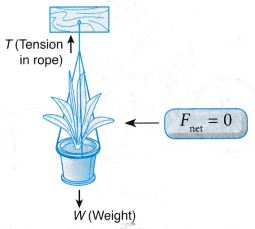
(a) The weight of the pot, W is balanced by the upward force of the tension, T of the rope.
(b) The net force acting on the flower pot is zero. - Figure shows a bird perching on a branch of a tree.

(a) The force of gravity, W (its weight) pulls it downward and the reaction of the branch, R pushes the bird upward to balance the weight.
(b) The net or total force acting on the bird is zero and the bird is at rest. - Figure shows a golf buggy moving in a golf course.

(a) The engine force, T which drives the buggy forward, has the same magnitude but acts in the opposite direction with the air resistance and frictional forces, F. The net horizontal force acting on the golf buggy is zero.
(b) The weight of the buggy, W is balanced by the reaction, R of the ground on the buggy. The net vertical force on the golf buggy is zero.
(c) The buggy moves with a constant velocity. - Figure shows an aircraft flying.

(a) The lift force, L from its wings is equal in magnitude but acts in the opposite direction to its weight, W. The net vertical force on the aircraft is zero.
(b) The forward thrust of the engine, T is equal but acts in the opposite direction to the drag or air resistance, F acting on the aircraft. The net horizontal force acting on the aircraft is zero.
(c) The aircraft flies at a constant velocity.
Unbalanced Forces
- When the forces acting on an object do not cancel out each other, a net force acts on the object.
- The forces are known as unbalanced forces and the net force is known as the resultant force.
- The following are examples of the effect of unbalanced forces acting on a body.
(a) A boy uses a force to lift a box from the floor. The lifting force has a greater magnitude than the weight of the box. The resultant force, F causes the stationary box to accelerate upward.
 (b) The forward thrust of the engine of a lorry is greater in magnitude than the frictional forces acting on the lorry. The resultant force, F causes the lorry to accelerate forward.
(b) The forward thrust of the engine of a lorry is greater in magnitude than the frictional forces acting on the lorry. The resultant force, F causes the lorry to accelerate forward.
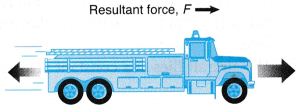 (c) A cyclist suddenly sees a cat in front of him. He presses the brakes hard causing the magnitude of the total frictional forces to be bigger than the forward force. The resultant force, F causes the bicycle to slow down or decelerate.
(c) A cyclist suddenly sees a cat in front of him. He presses the brakes hard causing the magnitude of the total frictional forces to be bigger than the forward force. The resultant force, F causes the bicycle to slow down or decelerate.
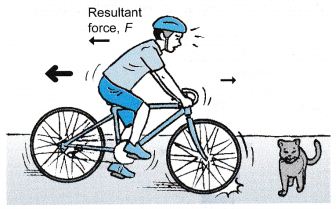
Relationship between Force, Mass and Acceleration
- When a net external force acts on an object, how does its acceleration depend on the force acting on the object and the mass of the object?
- In the following experiments, we will investigate some daily experiences and derive the relationship between the force, the mass and the acceleration of an object acted on by a net external force.
Experiment 1
Aim: To investigate the relationship between force and acceleration.
Problem: A hotel porter pushes a trolley of luggage. A net force acting on the trolley causes it to accelerate. What happens to the acceleration of the trolley if the magnitude of the net force is increased?

Hypothesis: The acceleration of an object increases when the net force acting on it increases.
Variables:
(a) Manipulated variable: Force acting on the object
(b) Responding variable: Acceleration of the object
(c) Fixed variable: Mass of the object
Operational Definition: A unit of force is represented by the force used to pull an elastic cord to a fixed length.
Materials: Ticker tape, cellophane tape, three identical elastic cords
Apparatus: Ticker timer, trolley, retort stands with clamps as support, 12 V a.c. power supply, plane
Method:

- The apparatus is set up as shown in Figure.
- The plane is adjusted to compensate friction so that the trolley will move down the plane with a constant velocity when given a slight push.
- A ticker tape is inserted through a ticker timer and is attached to the trolley with cellophane tape.
- An elastic cord is hooked onto the trolley and stretched until the end of the trolley. This will represent a unit of force, F.
- The ticker timer which is connected to a 12 V a.c. power supply is switched on and the trolley is pulled down the plane. The elastic cord is always maintained at the same length and parallel with the trolley.
- The ticker tape obtained is cut into 5-tick strips and a tape chart for the motion of the trolley is made. The acceleration of the trolley, a is calculated and recorded.

- Steps 3 to 6 are repeated with two and then three identical elastic cords as shown in Figure. For each case, the elastic cords are kept stretched until the end of the trolley and parallel to the trolley so that the forces are two units and three units respectively.
Results:

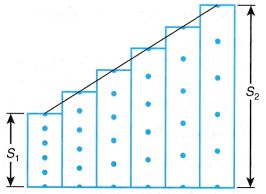

2. Based on Table, a graph of acceleration, a against force, F is plotted.
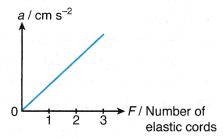
Discussion:
The graph of a against F in Figure is a straight line with a positive gradient.
The graph passes through the origin.
This shows that the acceleration, a of the trolley is directly proportional to the applied force, F.
Conclusion:
The acceleration of the trolley increases if the magnitude of the net force is increased. The acceleration of the trolley is directly proportional to the magnitude of the net force when the mass is constant.
Experiment 2
Aim: To investigate the relationship between mass and acceleration.
Problem: A hotel porter pushes a lightly-loaded trolley. A net force acting on the trolley causes it to accelerate.
What happens to the acceleration of the trolley if its mass is increased but the magnitude of the net force remains the same?

Hypothesis: The acceleration of an object decreases when its mass increases.
Variables:
(a) Manipulated variable: Mass of the object
(b) Responding variable: Acceleration of the object
(c) Fixed variable: Force acting on the object
Operational Definition: A unit of mass is represented by one trolley.
Materials: Ticker tape, cellophane tape, elastic cord
Apparatus: Ticker timer, trolley, retort stands with clamps as support, 12 V a.c. power supply, plane
Method:

- The apparatus is set up as shown in Figure.
- The plane is inclined to compensate friction so that the trolley will move down the plane with a constant velocity when given a slight push.
- A ticker tape is inserted through the ticker timer and is attached to the trolley with cellophane tape.
- An elastic cord is hooked onto the trolley and stretched until the end of the trolley. This will represent a unit of force, F.
- The ticker timer which is connected to a 12 V a.c. power supply is switched on and the trolley is pulled down the plane. The elastic cord is always maintained at the same length and parallel with the trolley.
- The ticker tape obtained is cut into 5-tick strips and a tape chart for the motion of the trolley is made. The acceleration of the trolley, a is calculated and recorded in Table.

- Steps 3 to 6 are repeated with two and then three identical trolleys stacked up. For each case, the elastic cord is kept stretched until the end of the trolley as shown in Figure.
Results:
1. Tabulation of results.

2. Based on the results in Table, graphs of acceleration, a against mass, m and a against 1/m are plotted.
Discussion:
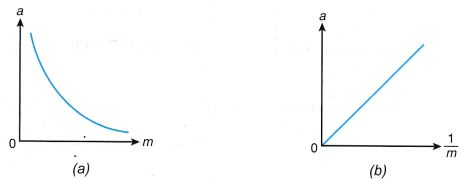
- The graph of a against m in Figure (a) is a curve with a decreasing negative gradient.
- This shows that as m increases, a decreases.
- The graph of a against 1/m passes through the origin as shown in Figure (b).
- This shows that the acceleration, a of the trolley is directly proportional to 1/m. In other words, the acceleration, a is inversely proportional to the mass, m.
Conclusion:
The acceleration of the trolley decreases if the mass of the trolley increases when the net force remains unchanged. The acceleration of the trolley is inversely proportional to the mass of the trolley when the net force is constant.